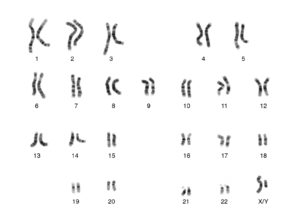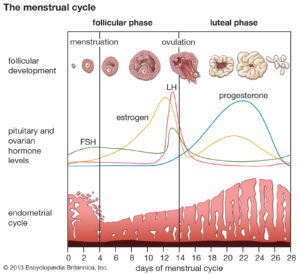Note: for the purposes of this article, the terms “gender” and “sex” are used interchangeably.
This week’s double parasha, Tazria-Metzora, begins with the laws of when “a woman conceives and gives birth to a male…” (Leviticus 12:2) The actual Hebrew wording here is ishah ki tazria, literally “when a woman gives seed”. Based on this, our Sages taught that if a woman “gives seed” first, the child will likely be male, whereas if a man “gives seed” first, the child will likely be female (Niddah 31a). How exactly is this to be understood?
The classic explanation is that if the woman climaxes first during intercourse, the child from that union is more likely to be male—and vice versa. Of course, this statement is not a guarantee, for there have surely been countless situations where this was not the case. Some say, therefore, it is only a segulah for having boys. A further issue with the statement is that, scientifically-speaking, while for the man the climax does coincide with “giving seed”, for a woman the emission of the ovum (egg) is not related to climax. A woman “gives seed” on a cyclical basis, roughly once per month. Having said that, there may be a scientific basis to our Sages statement after all.
In the 1960s, Dr. Landrum B. Shettles, one of the pioneers of in vitro fertilization technology, proposed a method for sex selection during conception. Physiologically, it is the male seed that determines the gender of the baby: sperm carrying a Y chromosome produce a male, while sperm carrying an X chromosome produce a female. (Eggs, meanwhile, always have an X chromosome.) The Y chromosome is significantly smaller than the X chromosome which would, together with other factors, make the “male” sperm lighter and faster than the “female” sperm. At the same time, male sperm are more fragile and less likely to survive the acidic conditions of the uterus.

A karyotype showing all 23 pairs of human chromosomes. Note the size of the Y chromosome compared to the X chromosome.
Based on this, to conceive a male, it is best to wait a few days so that the egg has travelled further down the fallopian tubes, allowing the male sperm to reach it faster, and before dying out. To conceive a female, it is best not to wait at all, and try to conceive earlier, while the eggs are deeper in the fallopian tubes, where male sperm are unlikely to reach. Shettles recommended that, if a couple desires a boy, they should start trying at ovulation time while if the couple wants a girl, they should try two or three days before ovulation. Ovulation is usually around Day 14 of the cycle.
Factoring in halakhah, if we add the seven clean days following menstruation, it generally comes to around Day 12 of the cycle. All other factors aside, this may favour the conception of a girl. Waiting a couple of days, meanwhile, might favour the conception of a boy. It is important to note that cycles vary; for some women ovulation might be a day or two earlier, or later. This may explain why some families have all girls, or all boys, for it is likely that conception always takes place on mikveh night, ie. at the same point in the cycle every time. Having said that, the Shettles Method is thought to be only 75% effective, and some studies say it isn’t effective at all, for there appear to be no major physiological differences between Y- and X-carrying sperm.
Intriguingly, the Shettles Method also recommends, as our Sages did, that a woman should climax first if the couple seeks a male child. This is because a woman’s uterine environment is acidic, but the secretions are actually more alkaline (basic), which diminishes some of that acid and makes it more likely for the male sperm to survive the journey.
The most significant factors are probably not biological at all, but spiritual. At the end of the day, God will send whichever gender is meant to be born. Thus, our Sages state that whoever is expecting a child and prays for a particular gender, “it is a vain prayer” (Berakhot 60a). However, Rav Yosef raises an objection to this statement, since we see in the Torah how Leah, after six boys, prayed for her next child to be a girl, the result being Dinah. It appears that praying for the desired gender does work! The Talmud resolves the contradiction with a Baraita:
The first three days [after intercourse], one should pray that the seed not putrefy. From the third day until the fortieth, one should pray that it will be male. From the fortieth day until three months, one should pray that it will not be deformed. From the third month until the sixth, one should pray that it will not be stillborn. And from the sixth month until the ninth, one should pray that it will be delivered safely.
So, one is permitted to pray for the desired gender of the child until the fortieth day of pregnancy. This is an incredibly precise scientific statement from our Sages, as today we know that the sex organs begin to form in the fetus around Day 42. While the chromosomes may have already determined the gender right at conception, God could certainly make a switch before Day 40 (who would know?) but after that point, the sex organs have begun to form and there is no going back. The Sages were also accurate regarding the putrefaction of the male seed, for today we know that sperm survives in the uterus for around three days, and no more than five days.
For the strict materialist-rationalist, there is nothing that can be done to select gender—it is just a game of chance, depending on which sperm penetrates the egg first. For the most pious person, there is no need to do anything either, for God knows best and it all depends on Above. Truly, it makes no difference, for each child is precious, and a miracle in its own right. I believe this is the deeper message behind our Sages’ debate on what is the ideal number of children that a couple should strive to have (Yevamot 62a):
Rabbi Natan taught: Beit Shammai say two males and two females, and Beit Hillel say a male and a female… It was alternatively taught [in a different Baraita]: Rabbi Natan said that Beit Shammai say a male and a female, and Beit Hillel say either a male or a female. Rava said: what is the reason? …as it is written: “He did not create it to be void; He formed it to be inhabited…” (Isaiah 45:18)
We are first given the most stringent opinion, that of Beit Shammai as expected, that a couple should ideally have two boys and two girls. At the end, we are given the most lenient opinion of Beit Hillel, the school of thought that Judaism is practically based on, which is that even a single boy or girl is enough to fulfil the mitzvah of reproduction. The Scriptural proof is a verse in Isaiah where the prophet quotes God as stating how He created the world to be full of life. The Sages are making an equivalence between the entire world and the birth of even a single child, which is enough to fulfil the mitzvah of populating the entire world. Each child is a world of his or her own and, as Abarbanel (1437-1508) comments on that verse in Isaiah, brings the world one step closer to the Final Redemption.


